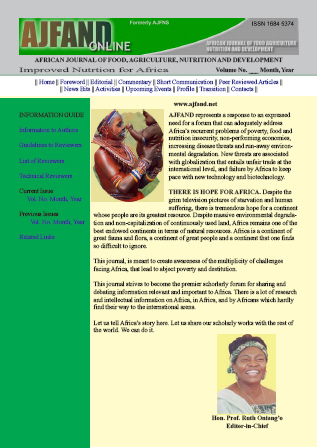
|
African Journal of Food, Agriculture, Nutrition and Development
Rural Outreach Program
ISSN: 1684-5358
EISSN: 1684-5358
Vol. 10, No. 5, 2010, pp. 2570-2586
|
 Bioline Code: nd10050
Bioline Code: nd10050
Full paper language: English
Document type: Research Article
Document available free of charge
|
|
|
African Journal of Food, Agriculture, Nutrition and Development, Vol. 10, No. 5, 2010, pp. 2570-2586
| en |
Assessment of anaemia and iron status of school age children (aged 7-12 years) in rural communities of Abia state, Nigeria
Onimawo, I.A.; Ukegbu, P.O.; Asumugha, V.U.; Anyika, J.U.; Okudu, H.; Echendu, C.A.; Nkwoala, C. & Emebu, P.
Abstract
The objective of this study was to investigate iron status of school children aged 7-12 years in some rural communities in Nigeria as well as identify factors associated with anemia in the children. A total of 249 school children, 120 males and 129 females aged between 7-12 years were used in the study. Haemomoglobin (Hb), haematocrit (PCV) and serum ferritin were used to determine anaemia and iron status in 208 children. The subjects were also screened for malaria parasites and worm infection to determine their impact on anaemia. C-reactive protein (CRP) was used as an indicator of inflammation or infection. Socioeconomic, anthropometric and body composition information were collected from the children, while dietary iron intake was determined using a combination of 24 hour dietary recall, food frequency questionnaire and weighed inventory technique. The values obtained for energy and nutrient intakes were compared with RDA recommendations. Anaemia was defined as Hb < 11.0mg/dl and iron deficiency was defined as serum ferritin levels below 12ug/dl. Correlation coefficient was used to evaluate association between anaemia and nutritional as well as health factors. The results showed that the prevalence of anaemia was 82.6%, while iron deficiency was 77.8%. The average daily iron intake was 30% below the recommended allowance. There was a high prevalence of inflammatory disorders as indicated by CRP. Malaria parasite and worm infestations were high in the children (93.2% and 41.8%, respectively). Anaemia was significantly associated with helminth infestation, malaria parasite and CRP. The children had a mean weight and height below the recommended standards. Of all the children in the study (n=249), 77% were both stunted and underweight while 56% were wasted. The body composition values of normal children (body fat, triceps, subscapula skinfold thicknesses and abdominal circumference) were significantly higher than those of the malnourished children (p<0.05). The percentage of children having low BMI (<14.59) was 23.69%.The need for malaria and helminth control in these communities is recommended.
Keywords
Anaemia, stunting, school, children, rural
|
| |
© Copyright 2010 African Journal of Food Agriculture, Nutrition and Development.
Alternative site location: http://www.ajfand.net/
|
|
